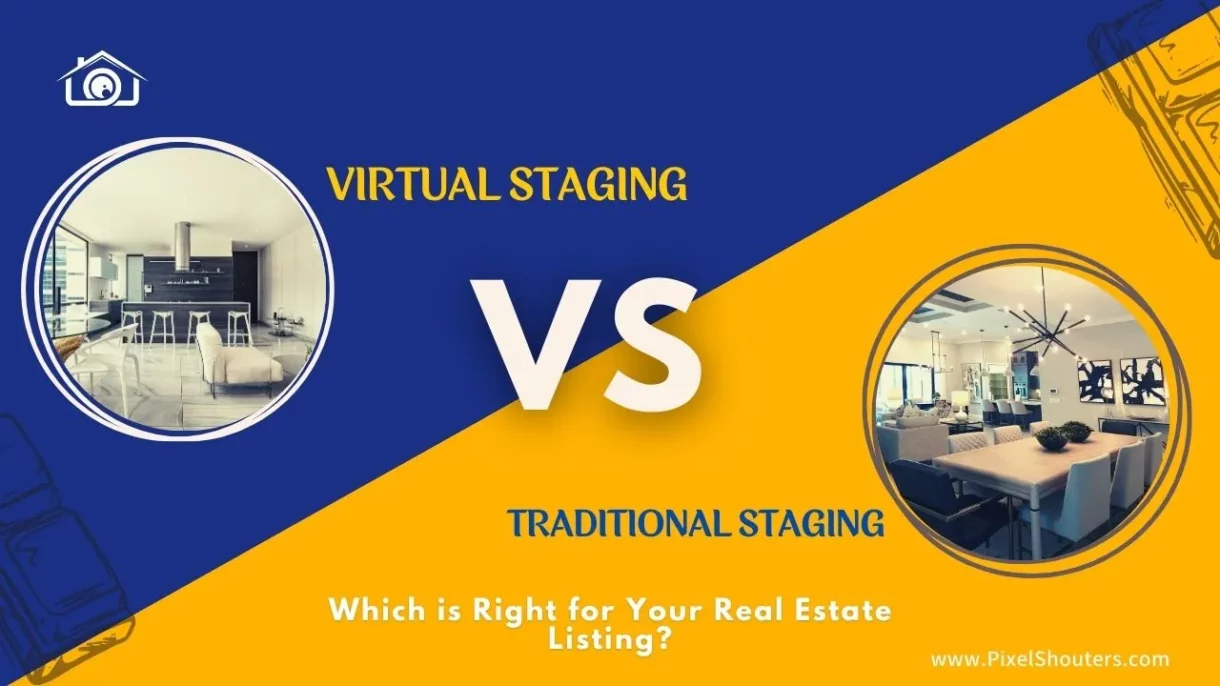Virtual Staging vs Real Staging: Which is Right for Your Real Estate Listing?
If you’re planning to sell a property, staging is an essential part of the marketing process. Staging involves decorating and furnishing a space to make it look more attractive and appealing to potential buyers. It can help to create an emotional connection with the property and showcase its potential. However, there are two primary methods of staging: virtual Staging vs real staging. In this article, we’ll compare these two approaches and help you decide which one is right for your real estate listing.
Table of Contents
I. What is Real Staging?
Real Staging involves physically furnishing a property for sale. This process typically involves hiring a stager, renting furniture, and arranging it in the space. The stager will work with the seller or real estate agent to create a look that will appeal to potential buyers.
One of the benefits of Real Staging is that it can create an emotional connection with buyers. When buyers walk into a home that’s been staged, they can see themselves living there. They can imagine relaxing on the couch, cooking in the kitchen, and sleeping in the bedroom. Real Staging helps to create a feeling of warmth and comfort that can be hard to achieve through other methods.

Another advantage of Real Staging is that it can showcase the property’s potential. When buyers see a home that’s been staged, they can envision how the space can be used. They can see how furniture can be arranged, and they can get a sense of how much space is available. This can be especially important for homes that are empty or have unusual layouts.
However, Real Staging can also have some downsides. For one, it can be expensive. Hiring a stager and renting furniture can add up quickly, and sellers may have to pay for storage if their home is on the market for an extended period. Additionally, Real Staging can be time-consuming. It can take days or even weeks to find the right furniture and arrange it in the space. Finally, Real Staging can be logistically challenging. Moving furniture in and out of a property can be difficult, especially if the property is on an upper floor or has narrow hallways.
II. What are the Pros and Cons of Real Staging?
Before deciding whether to use Real Staging, it’s essential to consider the pros and cons. Here are some of the advantages and disadvantages of Real Staging:
Pros:
- Increased buyer interest: Staged homes are often more attractive to buyers, which can lead to increased interest and more offers.
- Higher sale prices: According to the National Association of Realtors, staged homes typically sell for more than non-staged homes.
- More effective marketing: Staged homes look better in photos and videos, which can help to attract more potential buyers.
Cons:
- Cost: Real Staging can be expensive, especially for larger homes.
- Time commitment: Real Staging can take several days or even weeks to complete.
- Logistical challenges: Moving furniture in and out of a property can be challenging, especially if the property is on an upper floor or has narrow hallways.
III. What is Virtual Staging?
Virtual staging is a relatively new trend of staging a property that involves digitally rendering furniture and decor into photos of empty rooms. It’s a cost-effective way to stage a property without the need to physically move furniture in and out. With virtual staging, a real estate agent or seller can hire a virtual staging company, upload photos of the property, and choose furniture and decor to be placed in the photos. The virtual staging company will then create digital renderings of the space, adding the chosen furniture and decor to the images.
One of the benefits of virtual staging is that it can be done quickly and at a fraction of the cost of Real Staging. It’s also a great option for properties that are difficult to physically stage, such as homes that are already occupied or properties with narrow hallways or steep staircases. Additionally, virtual staging can be easily customized, allowing agents and sellers to change furniture and decor options based on the target audience and style of the home.

However, the virtual staging also has some potential downsides. For one, it can be challenging to make digital renderings look realistic. The furniture and decor may not match the scale or style of the room, leading to a less-than-ideal representation of the space. Additionally, virtual staging can sometimes mislead buyers. While virtual staging can help to showcase a property’s potential, it’s important to remember that the furniture and decor aren’t actually in the home. Buyers may be disappointed if they come to see a property and find that it looks very different from the digitally staged photos.
IV. What are the Pros and Cons of Virtual Staging?
Before deciding whether to use virtual staging, it’s important to consider the pros and cons. Here are some of the advantages and disadvantages of virtual staging:
Pros:
- Cost-effective: Virtual staging is typically less expensive than Real Staging.
- Quick turnaround: Virtual staging can be done quickly, often within a few days.
- Customizable: Virtual staging can be easily customized based on the target audience and style of the home.
Cons:
- Unrealistic representation: The digital renderings may not always look realistic and can mislead buyers.
- No physical furniture: Buyers may be disappointed if they come to see a property and find that it looks very different from the digitally staged photos.
- Limited flexibility: Virtual staging can only showcase the space in the way it was photographed, meaning it may not be able to address certain flaws in the property.
V. Which Staging Method is Right: virtual Staging vs real staging?
So, which method of staging is right for your real estate listing? Ultimately, the answer depends on a variety of factors, including your budget, timeline, and the property itself. Here are some key considerations to keep in mind:
- Budget: Real Staging can be more expensive than virtual staging, so if you have a limited budget, virtual staging may be the better option.
- Timeline: If you need to get a property on the market quickly, virtual staging may be a better choice since it can be done more quickly than Real Staging.
- Property condition: If a property is in need of repairs or has outdated features, Real Staging may be a better option. Physical staging can help to distract from flaws in the property and highlight its potential.
- Target audience: If you’re targeting a specific audience, such as families or young professionals, Real Staging may be more effective. You can create a look and feel that will appeal to your target demographic.

VI. Conclusion
Staging is an essential part of the real estate marketing process, but deciding whether to use traditional or virtual staging can be a challenge. While both methods have their advantages and disadvantages, it’s important to consider factors such as budget, timeline, and property condition before making a decision. Ultimately, the goal of staging is to create an emotional connection with potential buyers

[…] are two primary methods of staging: virtual Staging and real staging. Virtual staging is a cost-effective alternative to real staging, which involves renting furniture […]
[…] Read Full blog Here : Virtual Staging vs Real Staging: Which is Right for Your Real Estate Listing? […]
[…] why choose virtual staging over traditional staging? For starters, virtual staging is a cost-effective alternative to physically furnishing a property. […]